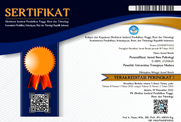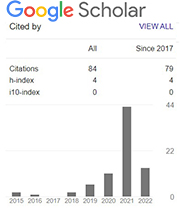Author Guidelines
DOWNLOAD TEMPLATE (PDF) / (DOCX)
AUTHOR’S WRITING GUIDELINES
PERSONIFIKASI : JURNAL ILMU PSIKOLOGI
PSYCHOLOGY STUDY PROGRAM, FACULTY OF SOCIAL AND CULTURAL SCIENCES, UNIVERSITAS TRUNOJOYO MADURA
_ The article is the results of research in social psychology, clinical psychology, developmental psychology, educational and industrial psychology, organizational psychology, and psychometrics that has never been published before in other publishing media.
_ Literature reviews and quantitative articles with one variable will be rejected.
_ The title of the article should be informative, containing not more than fourteen words in Indonesian and ten words in English. Avoid writing titles in capital letters. The title is written in Times New Roman, font size 14, bold, and single-spaced.
_ The name of the author is written without academic degree and placed under the title of the article along with the home institution and email address. Only the first author needs to write the email address. The author's name is written in Times New Roman, font size 12 and bold.
_ The abstract is written in two languages, Indonesian and English, single-spaced, at least 200 words. The keywords are written in 3-5 words (this applies to all types of writing). Written in Times New Roman, font size 12, single-spaced.
_ The article is typed in Times New Roman, font size 12, 1.5 spaced, paper size A4, written between 11-20 pages in length.
_ The systematic writing of the research article is: title; author's name; an abstract containing research objectives, methods, and results; keywords; introduction containing background, a short literature review, and research objectives; methods; results; discussion; conclusion; references (only works cited in the manuscript).
_ Tables, graphs, and figures should be quoted in text in order and the writing is placed at the bottom of tables, graphs, and figures in black and white and should be relevant to the information provided by the figures. Tables, graphs, and figures are centred.
_ References or reference sources wherever possible are the latest relevant literature (published within the last ten years).
_ References or reference sources wherever possible minimal 30 references.
_ References and citations use American Psychological Association (APA) standards. Authors are advised to use Mendeley Reference Manager to facilitate referrals.
_ The article submitted must be in doc. or docx format.
- The maximum limit for plagiarism is 20%. More than 20% will be rejected.
1) An example of a journal reference without Digital Objects (doi)
Klassen, R. M., Krawchuk, L. L., & Rajani, S. (2008). Academic procrastination of undergraduates: Low self-efficacy to self-regulate predicts higher levels of procrastination. Contemporary Educational Psychology, 33(4), 915-931.
2) An example of a journal reference with Digital Object Identifiers (doi)
Zacks, S., & Hen, M. (2018). Academic interventions for academic procrastination: A review of the literature. Journal of Prevention & Intervention in the Community, 46(2), 117–130. https://doi.org/10.1080/10852352.2016.1198154
3) An example of an online journal reference without Digital Object Identifiers (doi)
Melati, I. S., & Suhadianto. (2018). Efektivitas musik mozart untuk meningkatkan kreativitas verbal. Persona: Jurnal Psikologi Indonesia, 7(1), 69-78. Diunduh dari http://jurnal.untag-sby.ac.id/index.php/persona/article/view/1497 tanggal 20 Agustus 2019
4) An example of an online journal reference with Digital Object Identifiers (doi)
Zacks, S., & Hen, M. (2018). Academic interventions for academic procrastination: A review of the literature. Journal of Prevention & Intervention in the Community, 46(2), 117–130. Diunduh dari https://doi.org/10.1080/10852352.2016.1198154 tanggal 20 Agustus 2019
5) An example of a book reference
Ferrari, J.R., Jhonson, J.L. & McCown, W.G. (1995). Procrastination and task avoidance: Theory, research and treatment. New York: Plenum Press.
6) An example of an edited book reference
Block, J.H., & Burns, R.B. (1997). Mastery learning. Dalam L.S. Shulman (Ed.), Review of research in education (Vol. 4, hlmn. 3-49). Itasca, IL. Peacock.
7) An example of seminar proceedings references
Saraswati. (2001). Towards sustainable cities: encounter the problems in third world cities. Proceeding The 4th Quality in Research Seminar on Urbanization in the Information Age: New Perspective on the Transformation of Fast Growing Cities in the Pacific Rim (pp 165-177), Manila, ACM Press
8) An example of magazine references
Chamberlin, J., Novotney, A., Packard, E., & Price, M. (2008, May). Enhancing worker well-being: Occupational health psychologists convene to share their research on work, stress, and health. Monitor on Psychology, 39(5). 26-29.
9) An example of online magazine references
Clay, R. (2008, June). Science vs. ideology: Psychologists fight back about the misuse of research. Monitor on Psychology, 39(6). Diunduh dari http://www.apa.org/monitor/ tanggal 10 Agustus 2012.
10) An example of thesis or dissertation references that are not published
Adik, P.A. (2016). Hubungan kecerdasan emosi dengan perilaku delinkuen. (skripsi tidak diterbitkan). Fakultas Psikologi Universitas 17 Agustus 1945, Surabaya.
_ The reference list is arranged in the following manner and sorted alphabetically and chronologically;
_ The journal can be sent to:
ü Website https://journal.trunojoyo.ac.id/personifikasi after registering an account.
_ Correspondence with the editor can be sent to the email journal Personfikasi: personifikasi@trunojoyo.ac.id












